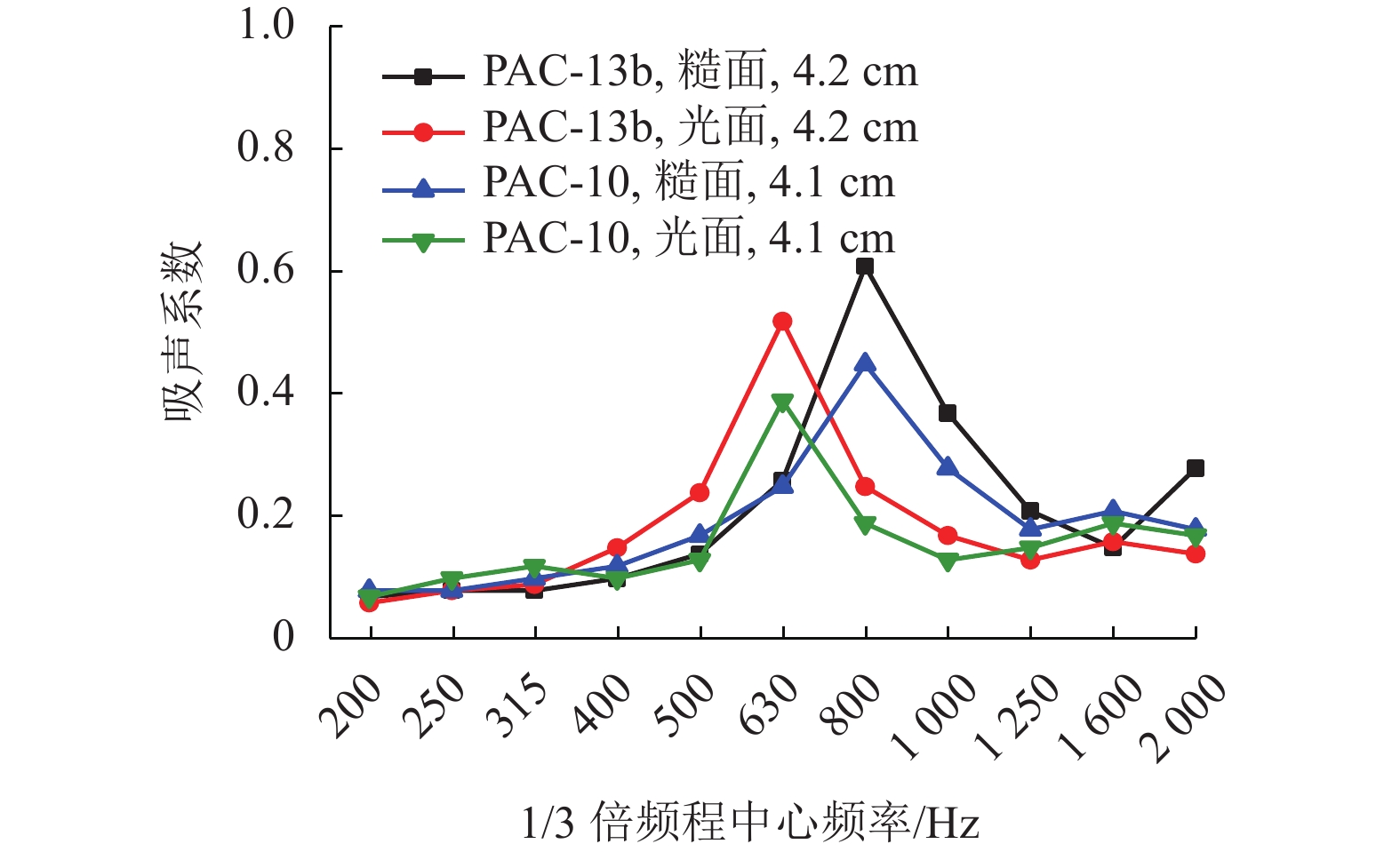Evaluation of Acoustic Performance of Porous Asphalt Concrete
-
摘要:
多孔沥青混合料的吸声性能对降低轮胎/路面噪声有重要影响,为此采用驻波管按1/3倍频对多孔沥青混合料(PAC)、沥青玛蹄脂碎石(SMA-13)和密级配沥青混合料(AC-13)的吸声频谱进行了测试,研究分析了级配类型、空隙率、试件厚度及表面纹理构造对混合料吸声性能的影响. 试验结果表明:PAC混合料的空隙率较大,其吸声频谱随频率呈先升后降的变化趋势,吸声性能远好于SMA-13和AC-13,并给出了吸声系数随连通空隙率的线性表达式;PAC的空隙率越高,公称最大粒径越大,平均吸声系数和峰值吸声系数均越大(降噪性能越好),吸声频谱的峰值频率越高;随着试件厚度减小,PAC的峰值吸声系数有所增大,吸声频谱峰值逐渐向高频方向移动,但平均吸声系数逐渐减小;SMA-13相比AC-13的平均吸声系数略大,同一PAC混合料试件的糙面接受声波相比光面接受声波时的平均吸声系数大13.9%,表面纹理构造也是影响PAC混合料吸声性能的重要因素. 空隙率、公称最大粒径和厚度的增加均有利于PAC混合料吸声性能提升,前两者更有益于吸收高频噪声,后者则有益于吸收低频噪声.
Abstract:The sound absorption performance of porous asphalt concrete has an important impact on reducing tire/pavement noise. The sound absorption coefficients of porous asphalt concrete (PAC), stone matrix asphalt (SMA-13) and a dense graded asphalt concrete (AC-13) are tested adopting the standing wave ratio method at one-third octave frequencies. The effects of several concrete properties are investigated; i.e., the grade distribution type, void content of the asphalt mixture, specimen thickness and surface texture. It is found that the sound absorption coefficients of PAC with a higher void content are much larger than those of SMA-13 and AC-13, and the sound absorption spectrum first increases and then decreases with the noise frequency increasing. The linear expressions of the sound absorption coefficient with the connected void content are proposed for asphalt mixture. A higher void content and larger maximum nominal particle size result in a larger peak and average value of the sound absorption coefficient (i.e., better noise reduction performance) for the PAC, with the peak value of the sound absorption spectrum gradually moving to a higher frequency. As the specimen thickness decreases, the average value of the sound absorption coefficient decreases for the PAC, and there is no obvious change in the peak value of the sound absorption coefficient whose corresponding frequency shifts to a high frequency gradually. For SMA-13 and AC-13 with similar void percentages, the peak and average value of the sound absorption coefficient of the former are slightly larger than those of the latter. For the same PAC specimen, the average value of the sound absorption coefficient measured using a rough-surface receiving incident sound wave is about 13.9% larger than that measured using a smooth-surface receiving sound wave, which indicates that the surface texture is an important factor affecting the sound absorption performance of the PAC. In summary, increases in the void content, maximum nominal particle size and thickness contribute to improving the sound absorption performance of the PAC. The two former factors are more beneficial to the absorption of high frequency noise, while the last factor is beneficial for the low frequency.
-
Key words:
- porous asphalt concrete /
- pavement noise /
- impedance tube /
- sound absorption coefficient
-
现代工业和社会经济的发展使汽车保有量与日俱增,带来的交通噪声污染问题日益严重. 交通噪声作为噪声污染的主要来源,长期暴露在噪声污染环境中容易使人出现生理和心理疾病[1-3]. 交通噪声的产生与交通量、交通流、行车速度以及路面状况相关[4]. 交通噪声的来源主要包括:车辆的动力系统、轮胎/路面的接触、车身与空气的摩擦[5]. 当车速度介于40~100 km/h时,轮胎/路面作用产生的噪声对交通噪声的贡献值最大,占比约90%[5-6]. 随着汽车工业的发展,动力系统减振降噪和轮胎制造技术日趋成熟,路面结构对降低轮胎/路面噪声将起着重要作用[7].
针对轮胎/路面噪声,欧洲、日本和美国在20世纪70年代后相继开展了低噪声路面的研究,发现多孔沥青路面是一种有效降低轮胎/路面噪声的结构形式,得到了广泛应用[8-9]. 多孔沥青路面由于多孔结构,尤其是较多的连通空隙为噪声在路面内部的传播提供了有效耗散的通道,表面纹理构造充当空气流通通道降低气压减弱了噪声的产生机制(如泵吸、空气共振和喇叭效应)[5]. 目前,公路沥青路面采用的热拌沥青混合料主要有:密级配沥青混合料(AC)、沥青玛蹄脂碎石(SMA)和开级配多孔沥青混合料(PAC)[10]. 相比SMA和AC沥青路面,多孔沥青路面可有效降低交通噪声3~6 dB[11-12]. 声波吸收是指声波在材料内部传播过程中会发生不规则的反射、折射和衍射等现象引起能量损耗[13]. 路面材料吸收声波能力的大小通常用“吸声系数”表征,即吸收声能与入射声能之间的比值,是反映路面材料吸声性能的重要指标[14]. 管测法和混响室法是测试材料吸声性能最常用的方法:前者包括驻波比法和传递函数法,是国家标准《声学阻抗管中吸声系数和声阻抗测量》(GB/T 18696.2—2002)[15]规定的测试方法;后者常用于建筑物室内装修材料对无规则入射声波吸收性能的测试,对于路面材料并不方便使用. 目前,也有些学者[9,16-17]采用了驻波比法对不同级配沥青混合料的吸声系数进行测试,主要是分析了空隙率对混合料吸声性能的影响,但并没有系统阐明级配类型、集料粒径、连通空隙率以及表面纹理等因素的影响;Gardziejczyk[18]采用现场近距离测试法对波兰境内两条多孔沥青路面的吸声性能进行了评价,并与钻取芯样的室内驻波比法测得的结果进行了对比分析,结果表明,两者具有良好的一致性. 因此,采用驻波比法测试沥青混合料的吸声系数,并对其吸声性能进行评价是可行的. 本文将采用驻波比法对多孔沥青混合料的吸声性能进行测试分析.
本文将着重研究分析级配类型、空隙率、连通空隙率、试件厚度以及表面纹理等因素对多孔沥青混合料吸声性能的影响,揭示各种因素影响下多孔沥青混合料的吸声规律.
1. 试验方法
1.1 原材料及试样制备
试验中制备8种级配的沥青混合料,包括6种多孔沥青混合料(PAC-16、PAC-13a、PAC-13b、PAC-13c、PAC-10和PAC-5)、沥青玛蹄脂碎石(SMA-13)和密级配沥青混合料(AC-13). 集料级配组成见表1. 试验采用苯乙烯-丁二烯嵌段共聚物(SBS)改性沥青和高黏改性沥青,后者是通过向前者中加入8.7%的高黏剂制备而成,两者在60 ℃的动力黏度分别为1840 Pa•s和725000 Pa•s;集料采用玄武岩,填料采用普通石灰岩矿粉. 制备多孔沥青混合料时采用高黏改性沥青,并加入混合料总质量0.1%的聚酯纤维;制备SMA-13和AC-13时采用SBS改性沥青,其中前者也加入混合料总质量0.1%的聚酯纤维. 根据《公路工程沥青及沥青混合料试验规程》(JTG E20—2011)[19]和《公路沥青路面施工技术规范》(JTG F40—2004)[20]确定沥青混合料的最佳沥青用量.
按照表1中的矿料级配和沥青用量,采用轮碾法制备了不同级配类型的混合料车辙板试件,每个车辙板钻取4个芯样(如图1),然后采用体积法测得不同芯样试件的空隙率,见表1. 将钻取的芯样试件放置在常温且通风良好的场所使之干燥,直至质量不再发生变化后测定其干燥重量;然后将芯样试件置于常温水中约1 min后,用木槌轻轻敲打芯样试件将空隙中残存的空气排出,测定其水中重量. 试件连通空隙率为
CV=V−(m0−mw)/(m0−mw)ρwwρwV×100% , (1) 式中:
V 为试件的体积;m0 和mw 分别为试件干燥状态和在水中的重量;ρw 为常温下水的密度.表 1 不同沥青混合料的级配组成Table 1. Gradation composition of different asphalt concrete% 试件编号 通过筛孔(mm)的质量百分比 油石比 空隙率 连通空隙率 19.000 16.000 13.200 9.500 4.750 2.360 1.180 0.600 0.300 0.150 0.075 PAC-16 100.0 94.5 82.0 51.0 20.5 16.0 12.5 10.0 7.5 5.5 4.0 4.7 19.5 13.2 PAC-13a 100.0 100.0 95.0 69.0 26.5 20.5 15.5 11.0 8.0 6.0 4.0 4.8 16.7 8.9 PAC-13b 100.0 100.0 90.5 63.0 19.5 14.0 12.5 9.0 7.0 5.5 4.0 4.8 20.0 12.6 PAC-13c 100.0 100.0 86.0 52.0 15.5 13.0 10.5 8.0 6.0 5.0 4.0 4.7 23.1 17.3 PAC-10 100.0 100.0 100.0 90.0 39.0 13.0 9.0 7.0 6.0 5.0 4.0 4.9 19.8 10.1 PAC-5 100.0 100.0 100.0 100.0 88.0 30.0 18.0 12.0 9.0 7.0 5.0 5.1 19.4 8.2 SMA-13 100.0 100.0 95.0 62.5 27.0 20.5 19.0 16.0 13.0 12.0 10.0 6.1 3.9 0.6 AC-13 100.0 100.0 95.0 76.5 53.0 37.0 26.5 19.0 13.5 10.0 6.0 4.6 4.2 0.7 1.2 吸声系数测试
采用驻波比法[15]测定不同级配沥青混合料的吸声系数,该系统主要包括声阻抗管、扬声器、声频控制器、数据分析仪和计算机等,如图2所示. 阻抗管为平直、刚性且气密性良好的圆管,一端装有试件,另一端为扬声器. 扬声器产生的平面入射波
pi 与从试件反射回来的声波pr 相叠加,在阻抗管内形成驻波p=pi+pr . 驻波比为特定声频下声压极小值和极大值振幅|pmax 和\left| {{p_{\min }}} \right| 的比值.由扬声器产生的沿阻抗管传播的
{p_{\text{i}}} (沿管轴负x方向传播,即负x方向为入射方向,见图2(a))为{p_{\rm{i}}}(x) = {p_0}{{\rm{e}}^{{\rm{j}}{k_0}x}} \text{,} (2) 式中:
{p_0} 为声压振幅;{k_0} 为波数,如式(3).{k_0} = \frac{\omega }{{{c_0}}} = \frac{{2{\text{π}} f}}{{{c_0}}} , (3) 式中:
\omega 为声波角频率;f 为声波频率,Hz;{c_0} 为声波在空气中传播的速度,m/s. 从试件反射回来的声波{p_{\text{r}}} 为{p_{\text{r}}}(x) = r {p_0}{{\rm{e}}^{ - {\rm{j}}{k_0}x}} , (4) 式中:
r 为复反射因数,如式(5),其中,\phi 为相位角.r = r' + jr'' = \left| r \right| {{\rm{e}}^{ - {\rm{j}}\phi }} = \left| r \right| \left( {\cos \;\phi + \sin \;\phi } \right) . (5) 基准面x=0处,驻波管中声阻抗如式(6).
{Z_{\text{s}}}(x) = {Z_0}\frac{{{p_{\text{i}}}(x) + {p_{\text{r}}}(x)}}{{{p_{\text{i}}}(x) - {p_{\text{r}}}(x)}} = {Z_0}\frac{{1 + r}}{{1 - r}} \text{,} (6) 式中:
{Z_0}{\text{ = }}{\rho _0} {c_0} , 为声波的特征阻抗,{\rho _0} 为空气密度,kg/m3.当入射波
{p_{\text{i}}}(x) 和反射波{p_{\text{r}}}(x) 同相位时,声压达到极大值{\left| {{p_{\max }}} \right|} ;当{p_{\text{i}}}(x) 和{p_{\text{r}}}(x) 反相位时,声压出现极小值{\left| {{p_{\min }}} \right|} ,则驻波比s为s = \frac{{\left| {{p_{\max }}} \right|}}{{\left| {{p_{\min }}} \right|}} = \frac{{\left| {{p_0}} \right| \left( {1 + \left| r \right|} \right)}}{{\left| {{p_0}} \right| \left( {1 - \left| r \right|} \right)}} = \frac{{1 + \left| r \right|}}{{1 - \left| r \right|}} , (7) 则吸声系数为
\alpha = 1 - {\left| r \right|^2} = 1 - {\left( {\frac{{s - 1}}{{s + 1}}} \right)^2} . (8) 特定声频下,可测得声波在阻抗管内产生的
\left| {{p_{\max }}} \right| 和\left| {{p_{\min }}} \right| ,并由式(6)和式(7)计算得到吸声系数. 通常情况,阻抗管中的声压采用对数计量,由声压极大值和极小值之间的级差\Delta L (分贝dB)可得驻波比s = {10^{{{\Delta L} \mathord{\left/ {\vphantom {{\Delta L} {20}}} \right. } {20}}}} ,从而求得\alpha 为\alpha = {{4 \times {{10}^{{{\Delta L} \mathord{\left/ {\vphantom {{\Delta L} {20}}} \right. } {20}}}}} \mathord{\left/ {\vphantom {{4 \times {{10}^{{{\Delta L} \mathord{\left/ {\vphantom {{\Delta L} {20}}} \right. } {20}}}}} {{{\left( {{{10}^{{{\Delta L} \mathord{\left/ {\vphantom {{\Delta L} {20}}} \right. } {20}}}}{\text{ + }}1} \right)}^2}}}} \right. } {{{\left( {{{10}^{{{\Delta L} \mathord{\left/ {\vphantom {{\Delta L} {20}}} \right. } {20}}}}{\text{ + }}1} \right)}^2}}} . (9) 阻抗管的工作频率范围(
{f_{\rm{l}}} < f < {f_{\rm{u}}} ,{f_{\rm{l}}} 和{f_{\rm{u}}} 分别为工作频率的下限和上限)取决于长度l和横截面直径d,为避免扬声器在管中激发高次波,频率f 需满足[18]:{{0.75{c_0}} \mathord{\left/ {\vphantom {{0.75{c_0}} {\left( {l - 3d} \right)}}} \right. } {\left( {l - 3d} \right)}} < f < {{0.5{c_0}} \mathord{\left/ {\vphantom {{0.5{c_0}} d}} \right. } d} . (10) 材料对不同噪声频率的吸声性能存有差异,车辆行驶产生的胎/路面噪声频率范围主要介于400~1600 Hz[21-22]. 为此,本文选择在11个1/3倍频程频率下对沥青混合料试件的吸声系数进行测试,包括200、250、315、400、500、630、800、1000、1250、1600、2000 Hz,进而综合评估不同级配沥青混合料的吸声性能. 为了保证扬声器发出的声波以平面波的形态沿阻抗管传播,选择阻抗管的直径为100 mm;对于更高的频率,需要采用较小直径的阻抗管(如60 mm和30 mm). 沥青混合料试件在1/3倍频程下200~2000 Hz范围内平均吸声系数
\overline \alpha 为\overline \alpha = \frac{1}{{11}}\left( {{\alpha _{200}}{\text{ + }}{\alpha _{250}}{\text{ + }}{\alpha _{315}}{\text{ + }} \cdots {\text{ + }}{\alpha _{2\;000}}} \right) , (11) 式中:
{\alpha _{200}} 、{\alpha _{250}} 、{\alpha _{315}} 、···、{\alpha _{2\;000}} 分别为频率为200、250、315、···、2000 Hz下的吸声系数.2. 测试结果分析与讨论
同一种级配组成的沥青混合料包括4个平行试件,每个试件均采用驻波比法测得1/3倍频程频率下的吸声系数. 以PAC-16和PAC-13b为对象,分别给出了4个平行试件的吸声频谱,如图3所示. 由图3可以看出:每一种级配沥青混合料中4个平行试件的吸声频谱非常接近,说明测试结果具有较好的可重复性,统计意义显著. 因此,每个频率下的吸声系数可取4个平行试件对应频率测试结果的平均值,从而得到不同级配沥青混合料的吸声频谱,然后分析级配类型、空隙率、连通空隙率、试件厚度以及表面纹理构造等因素对沥青混合料吸声性能的影响.
2.1 级配类型与空隙率的影响
公称最大粒径相同的情况下,图4给出了5种级配沥青混合料(PAC-13a、PAC-13b、PAC-13c、SMA-13和AC-13)的吸声频谱曲线. SMA-13和AC-13分别属于间断级配和密级配沥青混合料,空隙率分别为3.9%和4.2%;PAC-13a、PAC-13b、PAC-13c属于开级配多孔沥青混合料,空隙率分别为16.7%、20.0%、23.1%.
由图4可以看出:
1) 不同频率下AC-13的吸声系数基本位于0.1以下,没有明显的起伏变化,其平均吸声系数
\overline \alpha =0.0829;SMA-13的吸声系数随着频率变化略有起伏,并在800 Hz时出现了微小峰值,\overline \alpha =0.1082,略高于AC-13;虽然SMA-13和AC-13两者的空隙率和连通空隙率非常接近,但前者的平均吸声系数反而略大,主要原因在于SMA-13的表面纹理粗糙程度要好于AC-13,增加了声波在混合料试件表面耗散的通道以及折、反射的频次,更有利于声能的消耗.2) PAC-13a、PAC-13b、PAC-13c 3种混合料的吸声系数随着频率的增加先增加后减小;PAC-13a和PAC-13b吸声系数峰值对应的频率均为500 Hz,而空隙率最大的PAC-13c吸声系数峰值对应的频率为630 Hz,说明混合料的吸声频谱峰值随着空隙率的增加有向高频方向移动的迹象;上述3种混合料的峰值吸声系数分别为0.40、0.52和0.73;平均吸声系数分别为0.2012、0.2309和0.2659,空隙率每增加1%,平均吸声系数增加4.8%,说明混合料的吸声性能随着空隙率的增加而增强. 由上述分析可知,多孔沥青混合料的吸声性能远优于沥青玛蹄脂碎石和密级配沥青混合料.
2.2 公称最大粒径与连通空隙率的影响
PAC-5、PAC-10、PAC-13b和PAC-16 4种多孔沥青混合料的平均空隙率分别为19.4%、19.8%、20.0%、19.5%,所得吸声频谱曲线如图5所示. 由图5可以看出:上述4种混合料的吸声频谱随频率均先升后降,峰值吸声系数分别为0.39、0.43、0.52和0.58,对应的峰值频率分别为400、500、500、630 Hz,平均吸声系数分别为0.1973、0.2004、0.2309、0.2445. 由此可知,空隙率相接近的多孔沥青混合料,随着公称最大粒径的增加吸声频谱峰值向高频方向移动,吸声性能也会逐渐减弱. 主要是因为上述4种混合料的连通空隙率依次增大(分别为8.2%、10.1%、12.6%、13.2%),随公称最大粒径的增加而增大,较大的连通空隙率为声波在混合料中的传播提供了较多的通道,更有利于声能的吸收,相应的吸声性能也就越好.
由上述分析可知,连通空隙率是影响多孔沥青混合料吸声性能的主要因素,混合料吸声系数的平均值和峰值分别随连通空隙率的变化规律,如图6所示,并得到了吸声系数随连通空隙率近似线性增加的表达式,其中:
{\alpha _{\text{P}}} 为吸声系数峰值.2.3 试件厚度的影响
考虑到实际沥青路面厚度的差异性,图7给出了PAC-13b、PAC-10和PAC-5 3种沥青混合料分别在3种不同厚度下的吸声频谱曲线. 由图7可以看出:3种级配混合料试件在不同厚度下的吸声频谱随频率同样表现为先升后降的趋势;随着试件厚度的减小,同一种级配混合料的吸声频谱峰值逐渐向高频方向移动,有利于对高频噪声的吸收,对应的峰值吸声系数会略有增大,但平均吸声系数(表2)在逐渐减小,说明混合料的整体吸声性能在逐渐减弱. 这是因为试件厚度的减小会导致声波在混合料空隙通道中传播的路径缩减,受曲折空隙的阻挡次数减少,声波在空隙间发生反射和折射的次数也在减少,因而声波损失的能量也就越少,故试件越薄整体吸声性能越差.
2.4 试件表面纹理形态的影响
为了比较表面纹理构造对多孔沥青混合料吸声性能的影响,选择PAC-13b和PAC-10两种混合料为研究对象,试件厚度同为4.0 cm左右,测试试件糙面(图8(a))和光面(图8(b))分别接收入射声波时的吸声性能,测得吸声频谱见图9.
由图9可以看出:相比光面,同一多孔沥青混合料试件糙面接收入射声波时的峰值吸声系数较大,相应的峰值频率也较高;PAC-13b光面和糙面接收入射声波时的平均吸声系数分别为0.2101和0.1882;PAC-10光面和糙面接收入射声波时的平均吸声系数分别为0.1909和0.1583. 主要原因是入射声波传至混合料试件糙面时,声波会发生较多的折、反射次数,从试件表面反射回来色声波相互叠加后声能消耗较大,相应的吸声效果较好;光面接收入射声波时,情况恰好相反. 以上分析说明,混合料表面纹理构造对混合料吸声性能有显著影响,如何量化表面纹理的影响还有待深入研究.
表 2 不同厚度下沥青混合料试样的平均吸声系数Table 2. Average sound absorption coefficient of asphalt concrete samples with different thicknesses试样厚度 厚度≈5.3 cm 厚度 ≈4.1 cm 厚度 ≈2.1 cm PAC-13b 0.2309 0.2101 0.1836 PAC-10 0.2018 0.1909 0.1718 PAC-5 0.1973 0.1855 0.1691 3. 降噪水平分析
噪声水平在声学中通常是指声压和声强(dB),交通噪声的入射波撞击路面时部分进入内部空隙被吸收或损失掉,反射回来的声波能量必定小于入射声波能量,入射和反射声强普遍使用对数来度量[14],如式(12)、(13).
{L_{\text{I}}} = 10{\lg}\left( {{{p_{\text{e}}^2} \mathord{\left/ {\vphantom {{p_{\text{e}}^2} {p_{{\text{ref}}}^2}}} \right. } {p_{{\text{ref}}}^2}}} \right) \text{,} (12) \begin{split} & {L_{\text{R}}} = 10{\lg}\left[ {\left( {1 - \alpha } \right)\left( {{{p_{\text{e}}^2} \mathord{\left/ {\vphantom {{p_{\text{e}}^2} {p_{{\text{ref}}}^2}}} \right. } {p_{{\text{ref}}}^2}}} \right)} \right] \\ &\quad {\text{ = }}10{\lg}\left( {1 - \alpha } \right){\text{ + }}{L_{\text{I}}} , \end{split} (13) 式中:
{L_{\text{I}}} 和{L_{\text{R}}} 分别为入射声强和反射声强,dB;{p_{\text{e}}} 为待测声压,Pa;{p_{{\text{ref}}}} 为参考声压,取值为正常人耳对1 kHz声音所能觉察到的最低声压值,2.0 × 10−5 Pa;\alpha {\text{ = }}1.0 表示材料完全吸收声波,\alpha {\text{ = }}0 表示材料完全不吸声.利用式(12)减去式(13),便可得到材料在给定声源下的降噪水平值(降噪值),可表示为
N = {L_{\text{I}}} - {L_{\text{R}}} = - 10{\lg}\left( {1 - \alpha } \right) . (14) 将
\overline \alpha 和{\alpha _{\text{P}}} 分别代入式(14)中,求得相应的降噪值(图10),进而可以评价不同级配沥青混合料的整体吸声性能以及峰值频率下的吸声性能.由图10可以看出:PAC混合料的降噪水平远好于沥青玛蹄脂碎石(SMA-13)和密级配沥青混合料(AC-13);随着公称最大粒径增加,空隙率接近的PAC-16、PAC-13b、PAC-10、PAC-5等4种多孔沥青混合料(空隙率分别为19.5%、20.0%、19.8%和19.4%)的降噪水平依次降低;空隙率分别为16.7%、20.0%和23.1%的PAC-13a、PAC-13b和PAC-13c 3种多孔沥青混合料的降噪水平依次增大.
4. 结 论
针对轮碾法成型的不同级配沥青混合料车辙板钻心取样,并采用驻波比法对钻取的芯样试件进行吸声性能测试,得到如下结论:
1) 相比沥青玛蹄脂碎石SMA和密级配沥青混凝土AC,多孔沥青混合料PAC的吸声性能要好得多,PAC的吸声频谱随频率先增加后减小.
2) 随着空隙率的增加,沥青混合料的吸声系数逐渐增大,相应的吸声频谱峰值有向高频移动,空隙率每增加1%,平均吸声系数增加约4.8%.
3) 空隙率相近的PAC混合料,公称最大粒径越大,连通空隙率越高,吸声系数越大,吸声性能越好,并给出了吸声系数随连通空隙率的线性关系式;随着公称最大粒径的增加,PAC混合料的吸声频谱峰值逐渐向高频方向移动.
4) 随着试件厚度的变小,PAC混合料的吸声频谱峰值逐渐向高频方向移动,也就更有利于对高频噪声的吸收,平均吸声系数逐渐减小,整体吸声性能也就越差.
5) 相比密级配沥青混合料AC-13,沥青玛蹄脂碎石SMA-13的平均吸声系数较大;相比光面,同一个PAC混合料试件糙面接受入射声波时的平均吸声系数大约13.9%,说明混合料的表面纹理构造会显著影响其吸声性能.
-
表 1 不同沥青混合料的级配组成
Table 1. Gradation composition of different asphalt concrete
% 试件编号 通过筛孔(mm)的质量百分比 油石比 空隙率 连通空隙率 19.000 16.000 13.200 9.500 4.750 2.360 1.180 0.600 0.300 0.150 0.075 PAC-16 100.0 94.5 82.0 51.0 20.5 16.0 12.5 10.0 7.5 5.5 4.0 4.7 19.5 13.2 PAC-13a 100.0 100.0 95.0 69.0 26.5 20.5 15.5 11.0 8.0 6.0 4.0 4.8 16.7 8.9 PAC-13b 100.0 100.0 90.5 63.0 19.5 14.0 12.5 9.0 7.0 5.5 4.0 4.8 20.0 12.6 PAC-13c 100.0 100.0 86.0 52.0 15.5 13.0 10.5 8.0 6.0 5.0 4.0 4.7 23.1 17.3 PAC-10 100.0 100.0 100.0 90.0 39.0 13.0 9.0 7.0 6.0 5.0 4.0 4.9 19.8 10.1 PAC-5 100.0 100.0 100.0 100.0 88.0 30.0 18.0 12.0 9.0 7.0 5.0 5.1 19.4 8.2 SMA-13 100.0 100.0 95.0 62.5 27.0 20.5 19.0 16.0 13.0 12.0 10.0 6.1 3.9 0.6 AC-13 100.0 100.0 95.0 76.5 53.0 37.0 26.5 19.0 13.5 10.0 6.0 4.6 4.2 0.7 表 2 不同厚度下沥青混合料试样的平均吸声系数
Table 2. Average sound absorption coefficient of asphalt concrete samples with different thicknesses
试样厚度 厚度≈5.3 cm 厚度 ≈4.1 cm 厚度 ≈2.1 cm PAC-13b 0.2309 0.2101 0.1836 PAC-10 0.2018 0.1909 0.1718 PAC-5 0.1973 0.1855 0.1691 -
[1] KIM D R. Burden of disease from environmental noise[R]. Copenhague (Dinamarca): World Health Organization Regional Office for Europe, 2011. [2] DAMIAN C, FOSALAU C. Sources of indoor noise and options to minimize adverse human health effect[J]. Engineering and Management Journal, 2011, 10(3): 393-400. [3] SYGNA K, AASVANG GM, AAMODT G, et al. Road traffic noise,sleep and mental health[J]. Environmental Research, 2014, 131: 17-24. doi: 10.1016/j.envres.2014.02.010 [4] FREITAS E F. The effect of time on the contribution of asphalt rubber mixtures to noise abatement[J]. Noise Control Engineering Journal, 2012, 60(1): 1-8. doi: 10.3397/1.3676311 [5] SANDBERG U, EJSMONT J A. Tyre/road noise reference book[M]. Sweden: [s.n.], 2002. [6] WINROTH J, KROPP W, HOEVER G, et al. Investigating generation mechanisms of tyre/road noise by speed exponent analysis[J]. Applied Acoustics, 2017, 115: 101-108. doi: 10.1016/j.apacoust.2016.08.027 [7] LIU M, HUANG X, XUE G. Effects of double layer porous asphalt pavement of urban streets on noise reduction[J]. International Journal of Sustainable Built Environment, 2016, 5: 183-196. doi: 10.1016/j.ijsbe.2016.02.001 [8] GARDZIEJCZYK W, JASKULA P, EJSMONT J A, et al. Investigation of acoustic properties of poroelastic asphalt mixtures in laboratory and field conditions[J]. Materials, 2021, 14: 2649. doi: 10.3390/ma14102649 [9] CHU L, FWA T F, TAN K H. Eveluation of wearing course mix designs on sound absorption improvement of porous asphalt pavement[J]. Construction and Building Materials, 2017, 141: 402-409. doi: 10.1016/j.conbuildmat.2017.03.027 [10] KIM S K, PARK W J, LEE K H. Noise reduction capacity of a composite pavement system[J]. KSCE Journal of Civil Engineering, 2014, 18(6): 1664-1671. doi: 10.1007/s12205-014-0594-z [11] LIAO G, SAKHAEIFAR M S, HEITZMAN M, et al. The effects of pavement surface characteristics on tire/pavement noise[J]. Applied Acoustics, 2014, 76: 14-23. doi: 10.1016/j.apacoust.2013.07.012 [12] KRIVANEK V, PAVKOVA A, TOGEL M, et al. Cleaning low-noise surface as a basic condition for improving pavement’s axoustic absorption capability[J]. Arabian Journal for Science and Engineering, 2016, 41(2): 425-431. doi: 10.1007/s13369-015-1713-y [13] 杜功焕, 朱哲民, 龚秀芬. 声学基础[M]. 3版. 南京: 南京大学出版社, 2015: 131-150. [14] 王辉,董欣雨,邓乔,等. 沥青混合料吸声性能[J]. 建筑材料学报,2018,21(4): 634-638. doi: 10.3969/j.issn.1007-9629.2018.04.017WANG Hui, DONG Xinyu, DENG Qiao, et al. Sound absorption performance of asphalt mixutre[J]. Journal of Building Materials, 2018, 21(4): 634-638. doi: 10.3969/j.issn.1007-9629.2018.04.017 [15] 中国科学院声学研究所, 中国建筑科学院建筑物理研究所. 声学阻抗管中吸声系数和声阻抗的测量: GB/T 18696.1—2004 [S]. 北京: 中国国家标准化管理委员会, 2004. [16] VAITKUS A, RNDRIEJAUSKAS T, VOROBJOVAS V, et al. Asphalt waering course optimization for road traffic noise reduction[J]. Construction and Building Materials, 2017, 152: 345-356. doi: 10.1016/j.conbuildmat.2017.06.130 [17] 王岚,唐宝利,邢永明. 大孔隙胶粉改性沥青混合料吸声特性试验研究[J]. 工程力学,2009,26(增刊1): 181-184.WANG Lan, TANG Baoli, XING Yongming. Experimental study on sound absorption of crumb rubber modified asphalt mixture with large porosity[J]. Engineering Mechnics, 2009, 26(S1): 181-184. [18] GARDZIEJCZYK W. The effect of time on acoustic durability of low noise pavements-the case studies in Poland[J]. Transportation Research Part D: Transport and Environment, 2016, 44: 93-104. doi: 10.1016/j.trd.2016.02.006 [19] 交通运输部公路科学研究院. 公路工程沥青及沥青混合料试验规程: JTG E20-2011 [S]. 北京: 中华人民共和国交通运输部, 2011. [20] 交通运输部公路科学研究院. 公路沥青路面施工技术规范: JTG F40-2004 [S]. 北京: 中华人民共和国交通运输部, 2004. [21] KNABBEN R M, TRICHES G, GERGES S N Y, et al. Evaluation of sound absorption capacity of asphalt mixtures[J]. Applied Acoustics, 2016, 114: 266-274. [22] BURATTI C, MORETTI E. Traffic noise pollution: spectra characteristics and windows sound insulation in laboratory and field measurements[J]. Journal of Environmental Science and Engineering, 2010, 4(12): 28-36. 期刊类型引用(3)
1. 吴文亮,李陈月,代生林. 基于声学参数的OGFC沥青混合料吸声性能优化. 郑州大学学报(工学版). 2024(06): 18-24 .  百度学术
百度学术2. 宋柳,刘斌清,王小雯. 沥青混合料降噪特性多因素影响规律研究. 西部交通科技. 2024(12): 72-75 .  百度学术
百度学术3. 谢宏. 多孔沥青混合料耐久性能研究. 交通世界. 2023(35): 47-49 .  百度学术
百度学术其他类型引用(7)
-










 下载:
下载:






































































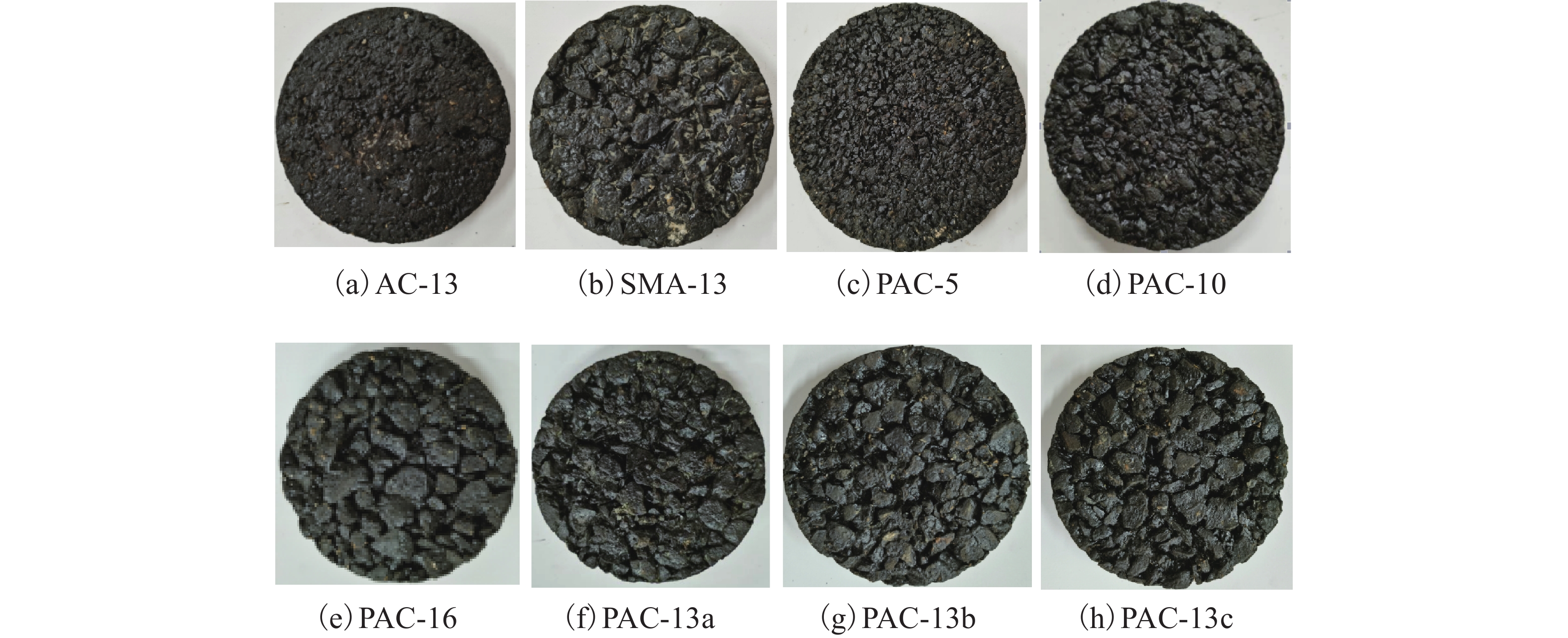
 下载:
下载:
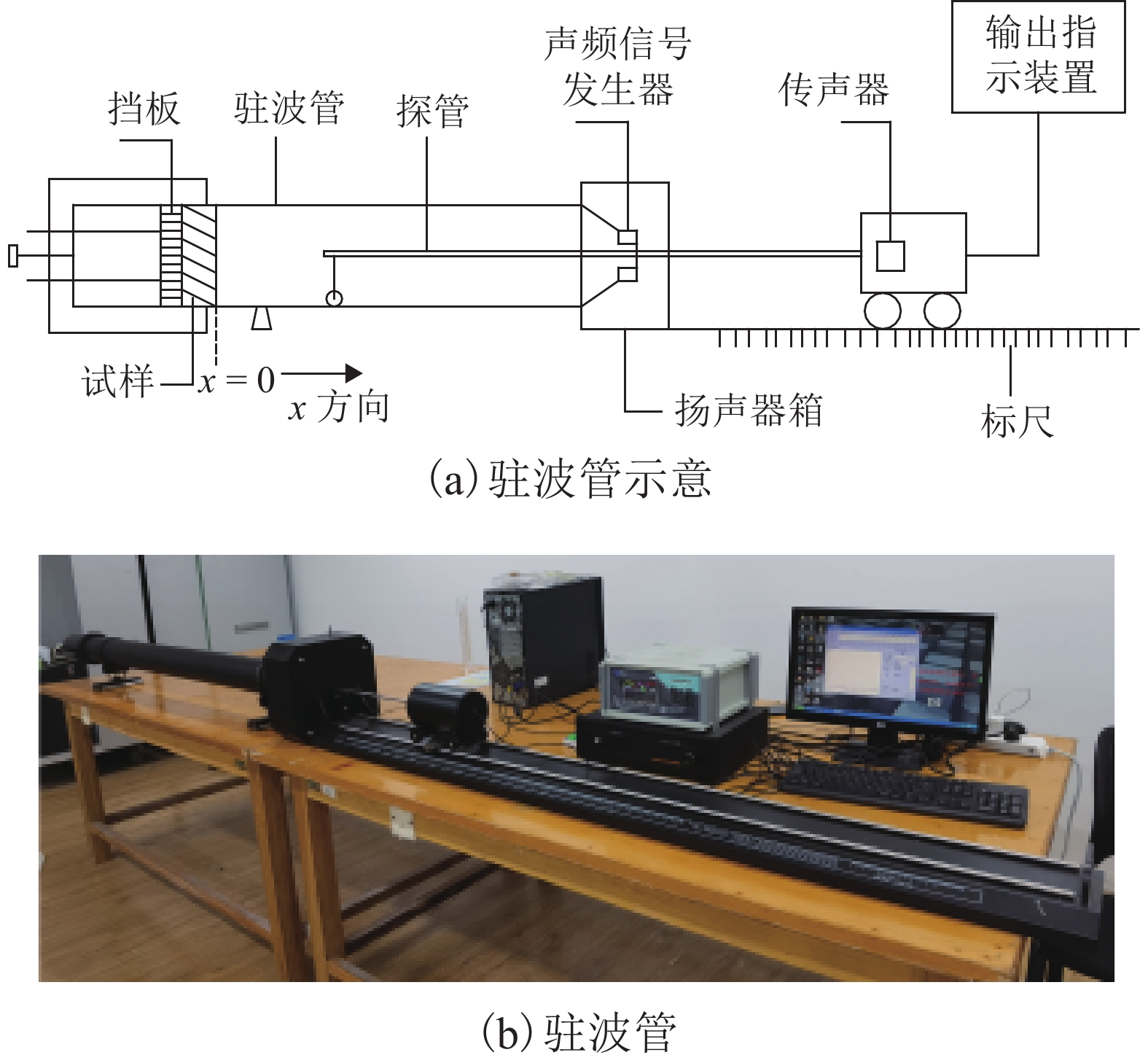
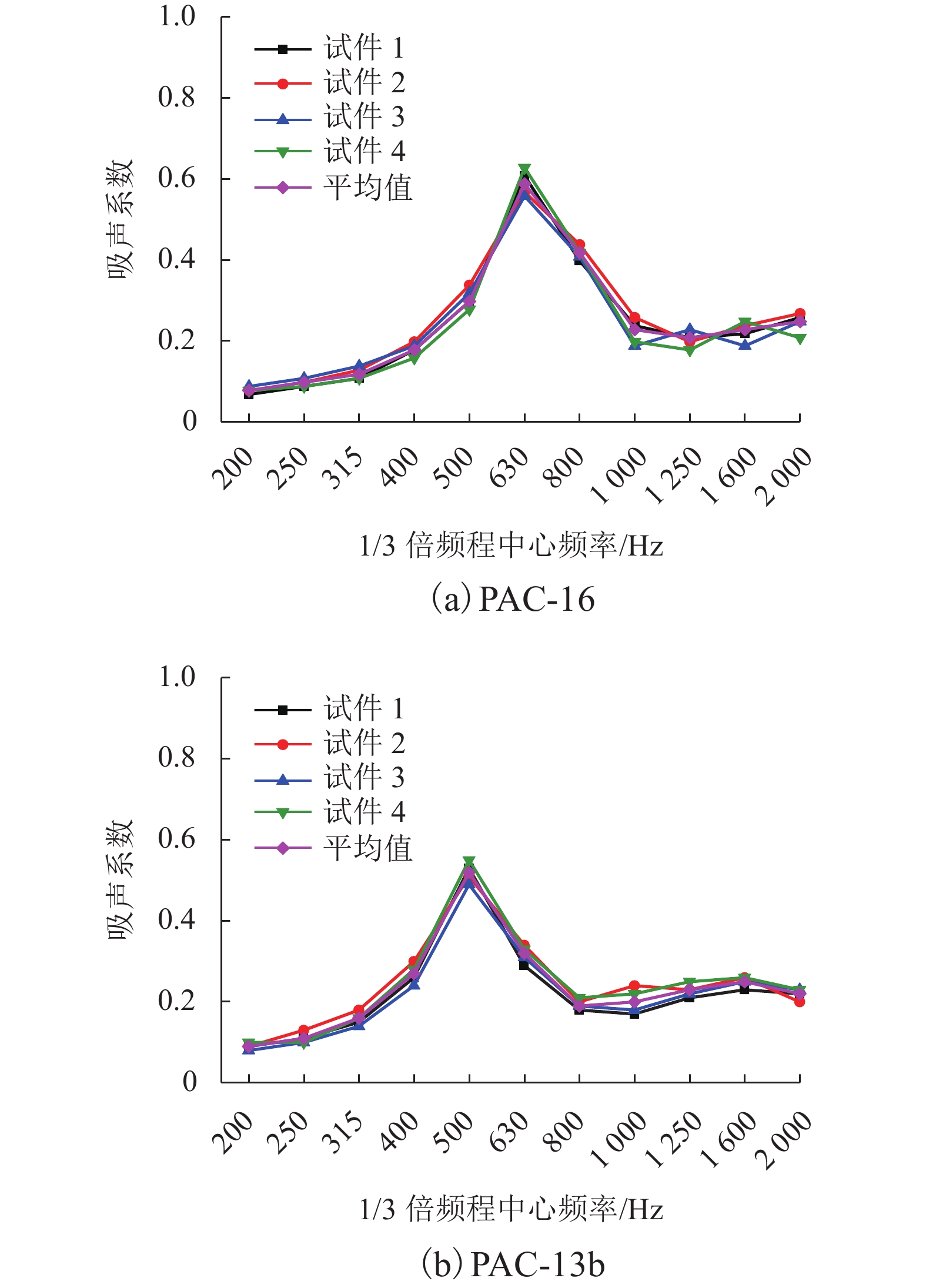
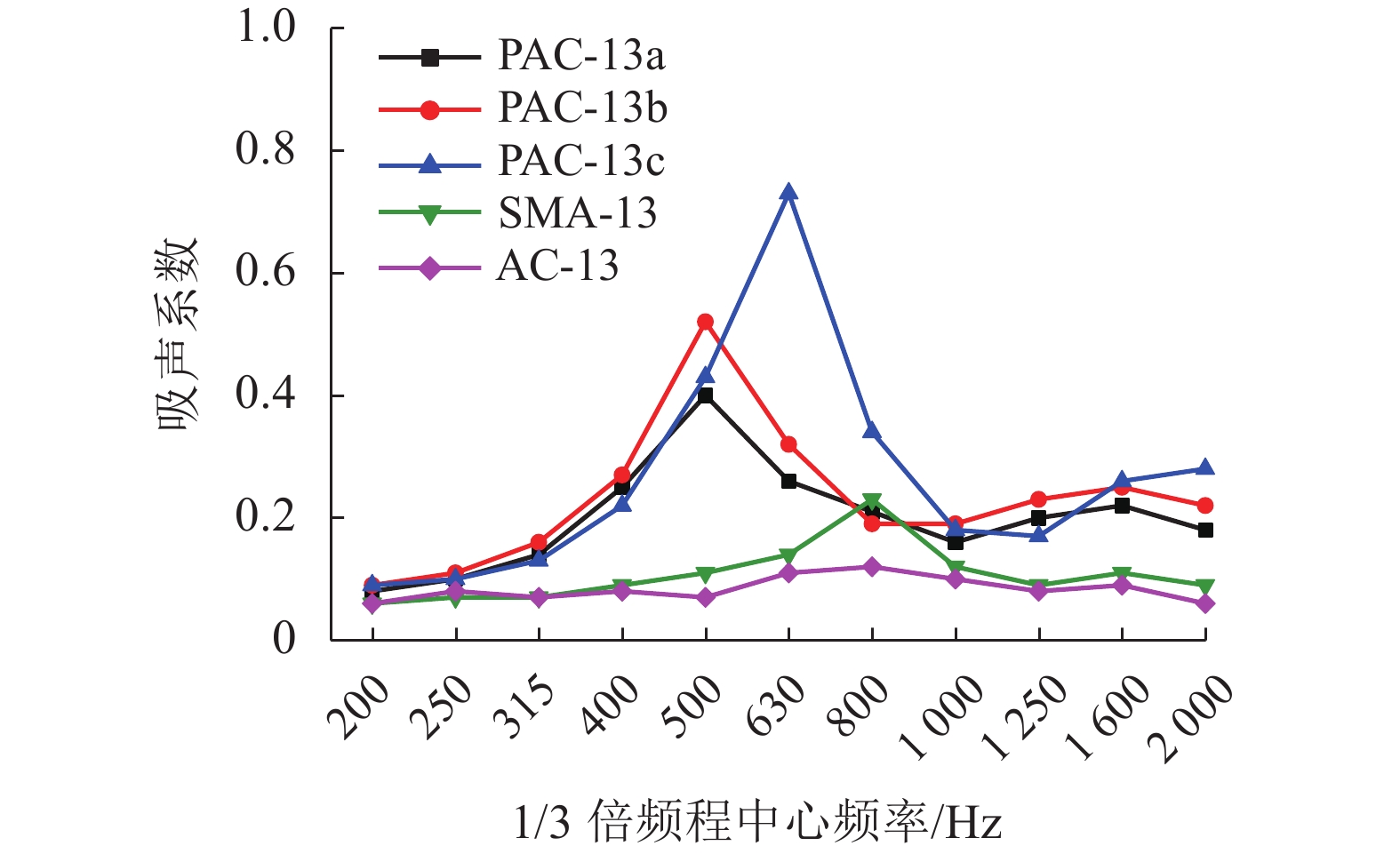
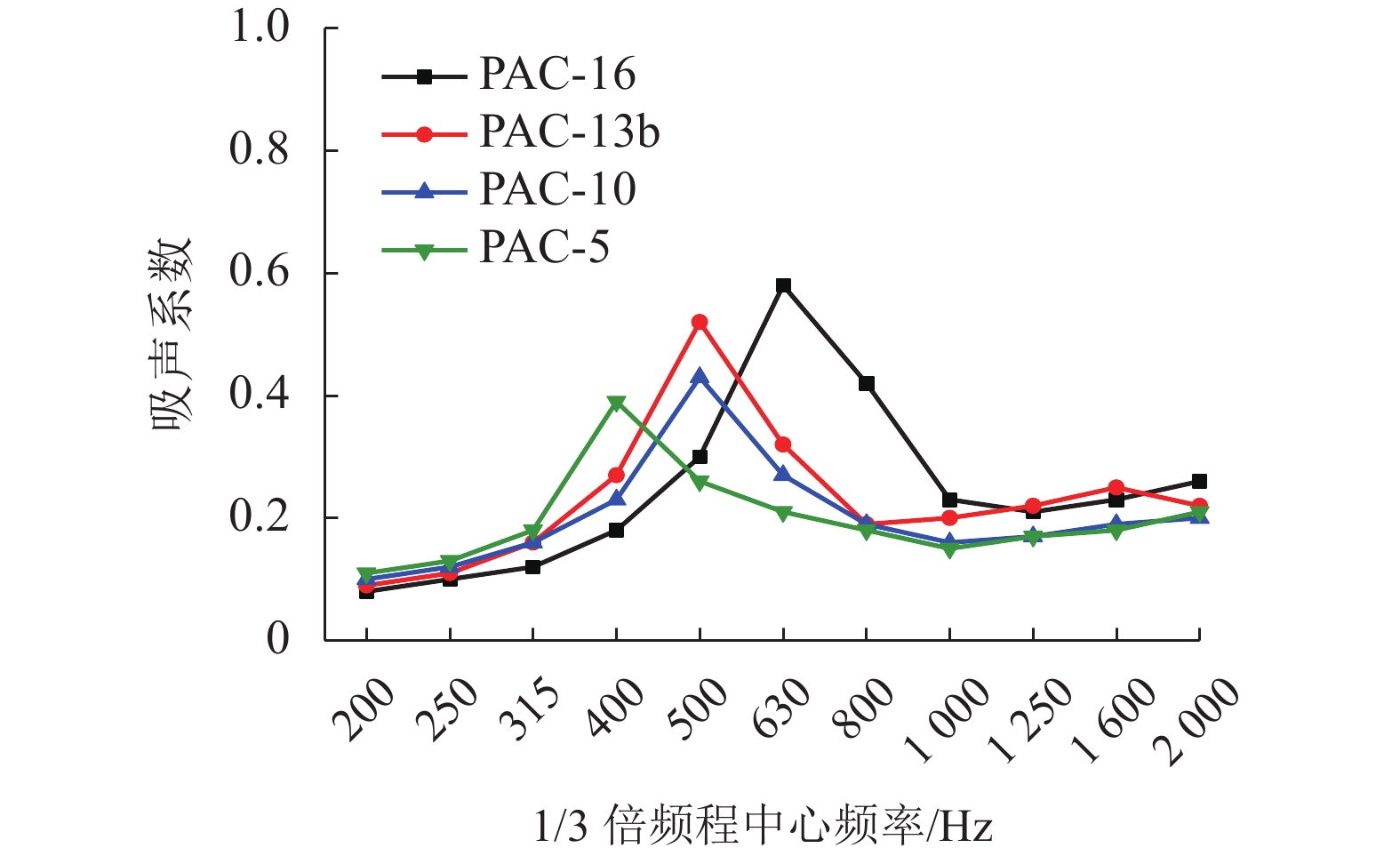
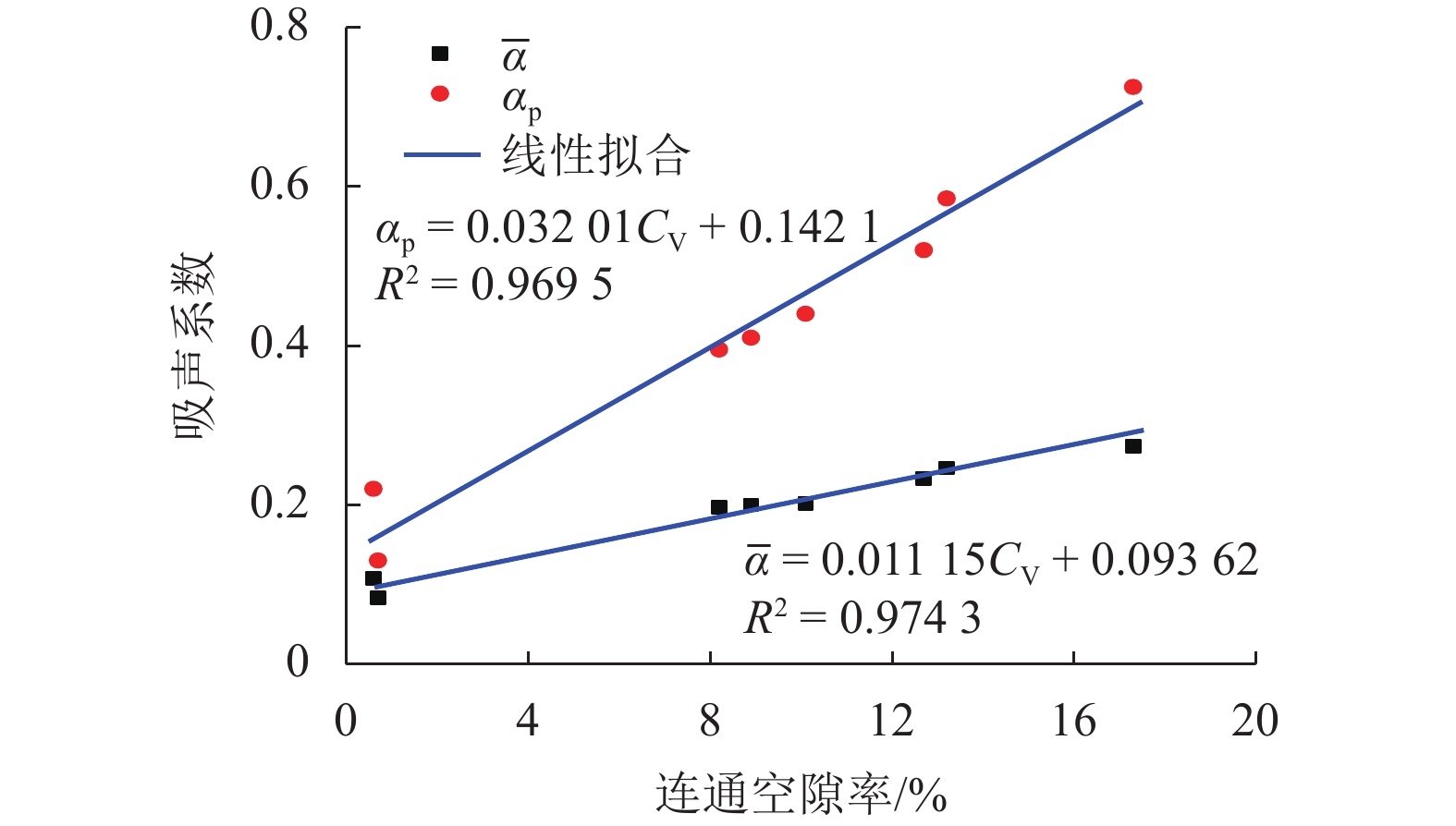
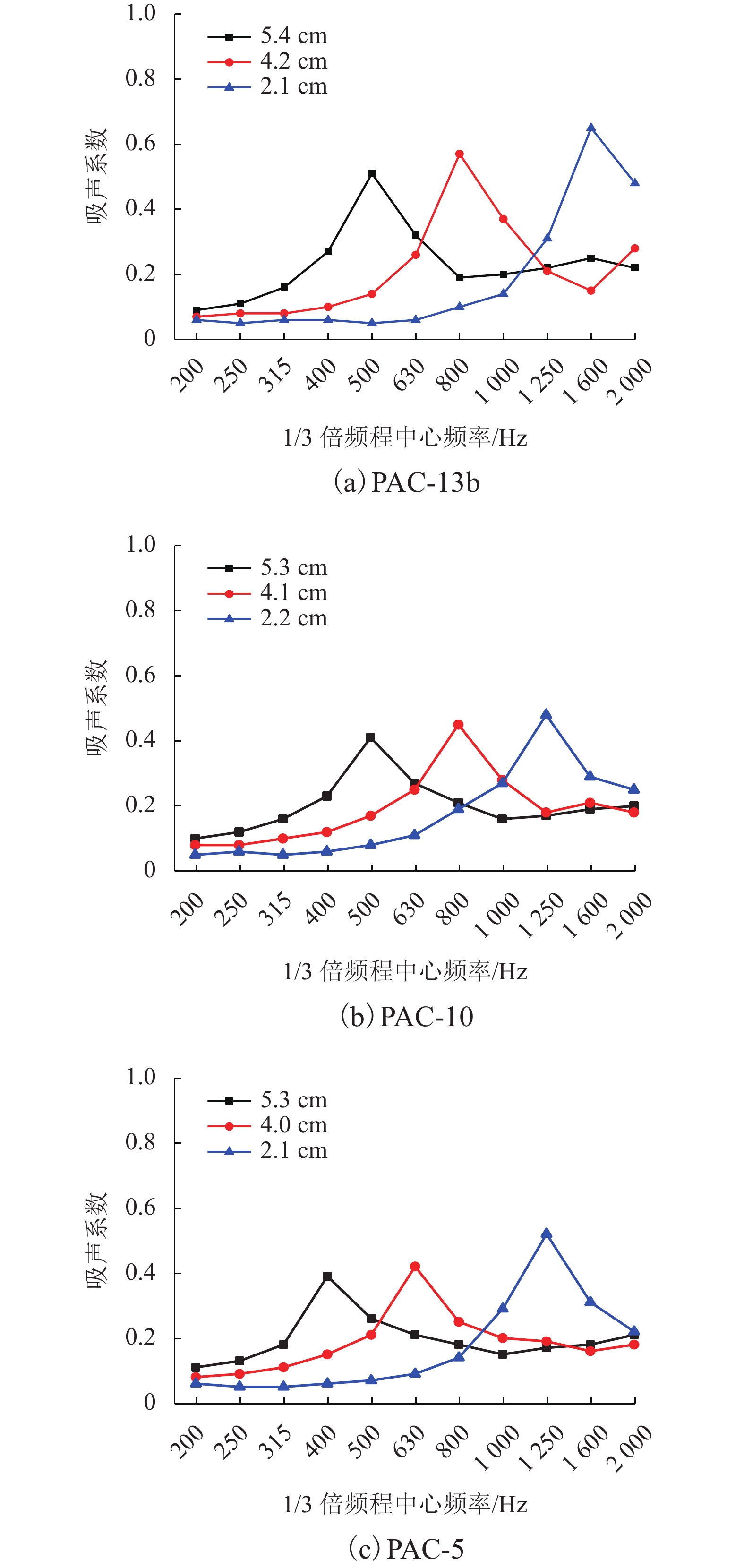


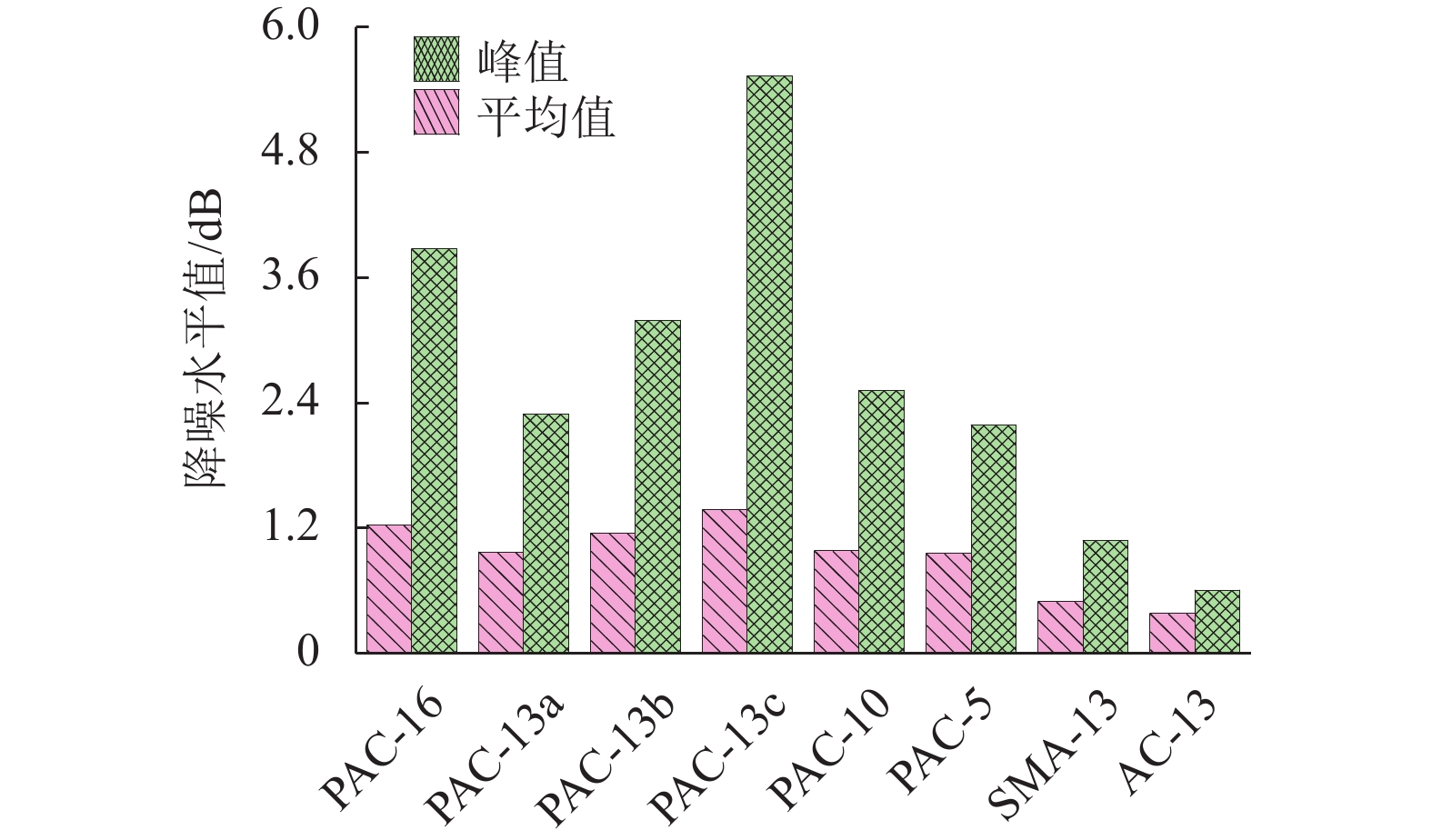
 百度学术
百度学术









